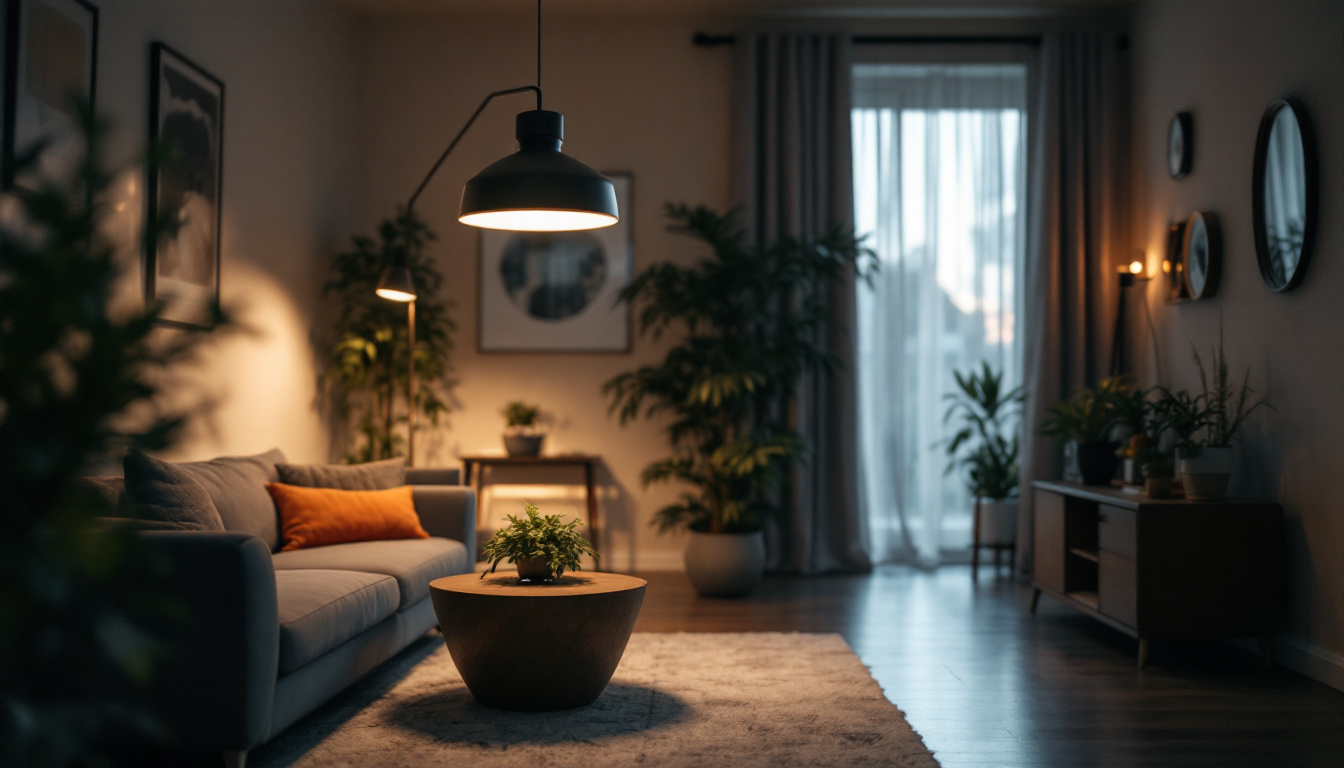

In the evolving landscape of indoor lighting, sensor lights have emerged as a popular choice for both residential and commercial applications. Their ability to enhance convenience and energy efficiency makes them an attractive option for many clients. However, as with any technology, there are pitfalls that lighting contractors must navigate to ensure successful installations. This guide aims to outline key considerations and strategies for effectively integrating indoor sensor lights into projects.
Indoor sensor lights are designed to automatically turn on or off based on the presence of people in a room. This functionality not only provides convenience but also contributes to energy savings by reducing unnecessary electricity usage. However, understanding the different types of sensors and their appropriate applications is crucial for a successful installation.
There are several types of sensors commonly used in indoor lighting, including passive infrared (PIR), ultrasonic, and dual technology sensors. Each type has its unique strengths and weaknesses that can impact performance.
PIR sensors detect body heat and motion, making them ideal for spaces where people frequently move in and out. Ultrasonic sensors, on the other hand, emit sound waves to detect motion, which can be beneficial in larger or more complex spaces. Dual technology sensors combine both methods, providing a more reliable detection mechanism. This combination minimizes the chances of false triggers, ensuring that lights only activate when necessary, which is particularly advantageous in environments where movement can be sporadic.
Indoor sensor lights can be effectively used in various settings, from residential homes to commercial buildings. In residential applications, they are often installed in hallways, bathrooms, and closets, where convenience is paramount. In commercial settings, they can be utilized in conference rooms, restrooms, and storage areas to enhance energy efficiency and safety.
Understanding the specific needs of each application is essential for selecting the right type of sensor light. For instance, a PIR sensor may be more suitable for a small hallway, while an ultrasonic sensor could be more effective in a larger open office space. Additionally, sensor lights can be integrated with smart home systems, allowing for remote control and programming. This integration not only enhances user experience but also provides opportunities for further energy management, such as scheduling lights to turn off during non-working hours or adjusting sensitivity levels based on the time of day.
Moreover, the placement of these sensors is critical to their effectiveness. For example, in a bathroom, a sensor placed too high may not detect lower body movements, while in a conference room, positioning the sensor away from windows can prevent false activations caused by external light changes. Proper installation and calibration can significantly improve the functionality of indoor sensor lights, making them a valuable addition to both home and workplace environments.
Despite the advantages of indoor sensor lights, improper installation can lead to significant issues that compromise their effectiveness. Awareness of common pitfalls can help contractors avoid costly mistakes.
One of the most critical factors in the performance of sensor lights is their placement. Sensors must be positioned to effectively detect motion without being obstructed by furniture or architectural features. For example, placing a sensor too high on a wall may limit its ability to detect motion at lower levels.
Additionally, consider the layout of the space. In open areas, a single sensor may suffice, but in more compartmentalized spaces, multiple sensors may be necessary to ensure complete coverage. Conducting a thorough assessment of the area before installation can help mitigate these issues. Furthermore, it is essential to account for potential obstructions that may arise over time, such as the addition of new furniture or changes in room configuration. Regularly revisiting the sensor placement can help maintain optimal functionality and ensure that the sensors continue to serve their intended purpose effectively.
Another common pitfall is neglecting the impact of ambient light on sensor performance. Many sensors come equipped with a built-in light level sensor that prevents them from activating in bright conditions. However, if the ambient light levels fluctuate significantly, this can lead to inconsistent performance.
Contractors should take into account the natural light sources in the space and adjust the sensitivity settings accordingly. In areas where natural light is abundant, it may be beneficial to set the sensor to a higher threshold, ensuring it only activates when necessary. Additionally, it is worth considering how seasonal changes can affect light levels within a space. For instance, during winter months when daylight is shorter, a sensor may need to be recalibrated to account for the reduced natural light, ensuring it remains responsive and functional throughout the year.
After installation, user education is often overlooked. Clients may not fully understand how to operate or adjust their new sensor lights, leading to frustration and potential misuse. Providing clear instructions and demonstrating how to adjust settings can enhance user satisfaction and ensure optimal performance.
Consider providing a user manual or a quick reference guide that outlines the key features and settings of the sensor lights. This proactive approach can help clients feel more confident in using their new lighting systems. Additionally, offering a follow-up session or a brief tutorial can reinforce their understanding and address any lingering questions. Engaging clients in discussions about their specific needs and preferences can also lead to tailored adjustments that enhance the overall user experience, ensuring that the sensor lights function seamlessly within their daily routines.
To maximize the benefits of indoor sensor lights, contractors should adhere to best practices during installation. These practices not only enhance the effectiveness of the lighting systems but also improve client satisfaction.
A thorough site assessment is essential before any installation begins. This involves evaluating the layout, identifying potential obstacles, and understanding the specific lighting needs of the space. Engaging with the client to discuss their preferences and requirements can provide valuable insights that inform the installation process.
During the assessment, take note of existing lighting conditions, the intended use of each space, and any specific concerns the client may have. This information will guide the selection of appropriate sensor types and placement strategies. Additionally, it’s beneficial to consider the architectural features of the space, such as windows and ceiling heights, which can significantly influence how light is distributed and perceived. By understanding these dynamics, contractors can recommend solutions that not only meet the functional requirements but also enhance the aesthetic appeal of the environment.
Once the sensor lights are installed, testing and calibration are crucial steps that should not be overlooked. This involves verifying that the sensors are functioning correctly and adjusting their settings to optimize performance.
Testing should include checking the detection range, sensitivity settings, and response times. Make sure to simulate various scenarios, such as different levels of activity and ambient light conditions, to ensure the sensors respond appropriately. This thorough testing process can help identify any issues before the project is completed. Furthermore, documenting the calibration settings and testing outcomes can serve as a valuable reference for future maintenance and troubleshooting, ensuring that both the contractor and client are aligned on the system’s capabilities and limitations.
After installation, offering ongoing support can significantly enhance client satisfaction and loyalty. Be available to address any questions or concerns that may arise after the project is completed. This could involve follow-up visits to check on the performance of the sensor lights or providing additional training on their use.
Consider establishing a maintenance schedule for clients who may require regular check-ups on their lighting systems. This proactive approach not only reinforces the contractor-client relationship but also positions the contractor as a trusted expert in the field. Additionally, providing clients with educational resources, such as user manuals or online tutorials, can empower them to make the most of their sensor lighting systems. Sharing tips on energy efficiency and optimal usage can further enhance their experience, demonstrating a commitment to not just the installation, but the overall satisfaction and value of the service provided.
The selection of high-quality products is paramount to the success of any lighting installation. Not all sensor lights are created equal, and choosing the right products can make a significant difference in performance and durability.
When selecting indoor sensor lights, it is essential to evaluate the product specifications carefully. Look for features such as adjustable sensitivity, time delay settings, and compatibility with existing lighting systems. These specifications can greatly influence the functionality and adaptability of the sensor lights in various environments.
Additionally, consider the energy efficiency ratings of the products. Opting for LED sensor lights can provide significant energy savings and reduce maintenance costs over time. Clients are increasingly interested in sustainable solutions, making energy-efficient products an attractive option.
Brand reliability is another critical factor to consider when choosing indoor sensor lights. Researching the reputation of manufacturers and reading reviews can provide insights into the quality and performance of their products. Look for brands that offer warranties or guarantees, as this can indicate confidence in their product quality.
Networking with other lighting contractors can also provide valuable recommendations on reliable brands and products. Sharing experiences and insights can help contractors make informed decisions when selecting sensor lights for their projects.
Indoor sensor lights offer numerous benefits, including convenience, energy efficiency, and enhanced safety. However, successful installation requires careful consideration of various factors, including sensor types, placement, and user education. By avoiding common pitfalls and adhering to best practices, lighting contractors can ensure that their clients enjoy the full advantages of these innovative lighting solutions.
Ultimately, the key to a successful installation lies in thorough planning, attention to detail, and ongoing support. By fostering strong relationships with clients and providing high-quality products, contractors can position themselves as leaders in the field of indoor lighting solutions.
Ready to elevate your lighting projects with the best sensor lights on the market? Look no further than LumenWholesale for all your lighting needs. We provide contractors with exceptional, spec-grade lighting products at unbeatable wholesale prices, ensuring you get the most value for your investment. With our direct approach, you avoid inflated markups and enjoy the convenience of free shipping on bulk orders. Don’t compromise on quality or cost—choose LumenWholesale for reliable, high-performance lighting solutions that meet the highest industry standards. Wholesale Lighting at the Best Value is just a click away. Experience the difference today!

Discover how the right lighting can enhance retail spaces and boost profits with our comprehensive guide for lighting contractors.

Discover the essential insights lighting contractors need about vapor tight lighting.

Discover how 100 Watt LED high bay lights are revolutionizing lighting contractors’ projects with enhanced efficiency, cost savings, and superior illumination.

Discover the pitfalls of purchasing architectural round pendant lights in bulk from local distributors.
Get notified when NEW deals are released.
Optimize your budget with wholesale discounts.
Only top-quality, specification-grade lighting products.
No additional costs at checkout - what you see is what you pay.
We understand the unique needs of contractors.